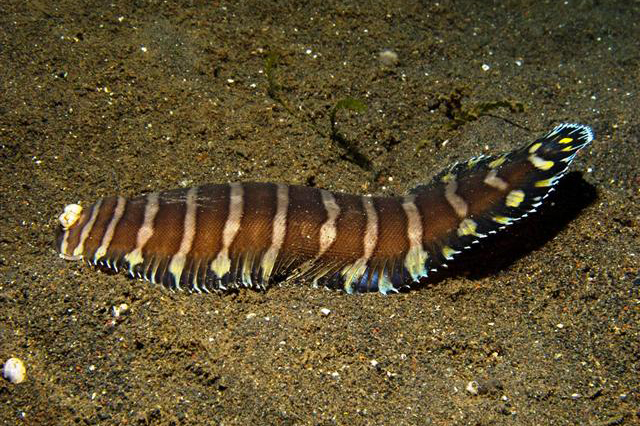Thickray Sole, Aesopia cornuta Kaup 1858

A Thickray Sole, Aesopia cornuta, at Bali, Indonesia. Source: Andrey Ryanskiy / FishBase. License: CC BY Attribution-NonCommercial
A greyish to yellowish-brown sole, with darker 12-16 bars edged with black on the head, body and fins (bars may be yellowish on the fins), and a black caudal fin with bright yellow blotches. The first dorsal-fin ray is thickened and elongate with many hair-like projections on the upper surface.
The Thickray Sole often lies buried in sand with only the eyes exposed.
Thickray Sole, Aesopia cornuta Kaup 1858
More Info
|
Distribution |
Shark Bay to off the Joseph Bonaparte Gulf, Western Australia, and east of Ashmore Reef in the Timor Sea, and off Hinchinbrook Is, Queensland, to ENE of Brooms Head, New South Wales, including the Coral Sea off Townsville. Elsewhere, widespread in the tropical, Indo-west Pacific: South Africa and the Red Sea east to New Caledonia, north to Japan. Inhabits sandy and muddy areas. |
|
Features |
Dorsal fin 69-79; Anal fin 57-68; Pectoral fin 11-15; Lateral line 90-100; Vertebrae 46. Body elongate, depth 2.7-3.0 in SL; dorsal, anal and caudal fins united; 1st ray of dorsal fin enlarged and free. Scales on both sides smooth, cycloid or weakly ctenoid. |
|
Etymology |
The specific name is from the Latin cornuta (= horned), in reference to the elongate first dorsal-fin ray on the forehead that is free from the rest of the dorsal fin. |
|
Species Citation |
Aesopia cornuta Kaup, 1858, Archiv für Naturg. 24(1): 98. Type locality: British India. |
|
Author |
Bray, D.J. 2023 |
|
Resources |
Thickray Sole, Aesopia cornuta Kaup 1858
References
Allen, G.R. 1997. Marine Fishes of Tropical Australia and South-east Asia. Perth : Western Australian Museum 292 pp. 106 pls.
Allen, G.R. & Erdmann, M.V. 2012. Reef Fishes of the East Indies. Volumes I-III. Tropical Reef Research, Perth, Australia. 1292 pp. University of Hawai'i Press
Allen, G.R. & Swainston, R. 1988. The Marine Fishes of North-Western Australia. A field guide for anglers and divers. Perth, WA : Western Australian Museum vi 201 pp., 70 pls.
Gloerfelt-Tarp, T. & Kailola, P.J. 1984. Trawled Fishes of Southern Indonesia and Northwest Australia. Jakarta : Dir. Gen. Fish. (Indonesia), German Tech. Coop., Aust. Dev. Ass. Bur. 406 pp.
Heemstra, P.C. & Gon, O. 1986. Family No. 262: Soleidae. pp. 868-874 in Smith, M.M. & Heemstra, P.C. (eds). Smith's Sea Fishes. Johannesburg : Macmillan South Africa xx + 1047 pp. 144 pls. See ref at BHL
Kaup, J.J. 1858. Uebersicht der Soleinae, der vierten Subfamilie der Pleuronectidae. Archiv für Naturgeschichte 24(1): 94-104 See ref at BHL
Kuiter, R.H. & Tonozuka, T. 2001. Pictorial guide to Indonesian reef fishes. Part 2. Fusiliers - Dragonets, Caesionidae - Callionymidae. Zoonetics, Australia.
Johnson, J.W. 2010. Fishes of the Moreton Bay Marine Park and adjacent continental shelf waters, Queensland, Australia. pp. 299-353 in Davie, P.J.F. & Phillips, J.A. Proceedings of the Thirteenth International Marine Biological Workshop, The Marine Fauna and Flora of Moreton Bay. Memoirs of the Queensland Museum 54(3)
Munroe, T. 2016. Aesopia cornuta. The IUCN Red List of Threatened Species 2016: e.T56852510A57244866. https://dx.doi.org/10.2305/IUCN.UK.2016-3.RLTS.T56852510A57244866.en. Accessed on 22 January 2023.
Sainsbury, K.J., Kailola, P.J. & Leyland, G.G. 1985. Continental Shelf Fishes of Northern and North-Western Australia. Canberra : Fisheries Information Service 375 pp. figs & pls.



